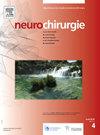颅骨成形术中硅胶层下面罩诱导的颅膜:一种减压颅骨切除术后脑膜再生的自然技术
IF 1.4
4区 医学
Q4 CLINICAL NEUROLOGY
引用次数: 0
摘要
脑膜重建和继发性脑积水是颅骨减压术后的突出问题。我们提出了一种简单的技术,在减压颅骨切除术中使用硅胶片倚靠在打开的硬脑膜和大脑上。在颅骨成形术中,硅胶层的移除显示,一层新的半透明的、高度血管化的膜已经在下面自然生成,覆盖着硬脑膜瓣和大脑。我们相信这种由Masquelet技术产生的新颅膜可以覆盖大面积的脑膜缺损,特别是在战时颅脑损伤后,并且由于其下更好的脑脊液循环,也可以帮助减少继发性脑积水的发生。本文章由计算机程序翻译,如有差异,请以英文原文为准。
Masquelet induced cranial membrane under silicone layer during cranioplasty: Toward a natural technique for regeneration of meninges after decompressive craniectomy
Reconstruction of the meninges and secondary hydrocephalus are salient issues following decompressive craniectomy. We propose a simple technique using a silicone sheet leaning on the opened dura mater and the brain during decompressive craniectomy. During cranioplasty, the removal of the silicone layer reveals that a new translucent and highly vascularized membrane has been naturally generated underneath, covering the dura mater flaps and the brain. We believe that this new cranial membrane arising from Masquelet’s technique could allow covering large meningeal defects notably after wartime craniocerebral injury, and could also help reducing the occurrence of secondary hydrocephalus thanks to better cerebrospinal fluid circulation underneath.
求助全文
通过发布文献求助,成功后即可免费获取论文全文。
去求助
来源期刊

Neurochirurgie
医学-临床神经学
CiteScore
2.70
自引率
6.20%
发文量
100
审稿时长
29 days
期刊介绍:
Neurochirurgie publishes articles on treatment, teaching and research, neurosurgery training and the professional aspects of our discipline, and also the history and progress of neurosurgery. It focuses on pathologies of the head, spine and central and peripheral nervous systems and their vascularization. All aspects of the specialty are dealt with: trauma, tumor, degenerative disease, infection, vascular pathology, and radiosurgery, and pediatrics. Transversal studies are also welcome: neuroanatomy, neurophysiology, neurology, neuropediatrics, psychiatry, neuropsychology, physical medicine and neurologic rehabilitation, neuro-anesthesia, neurologic intensive care, neuroradiology, functional exploration, neuropathology, neuro-ophthalmology, otoneurology, maxillofacial surgery, neuro-endocrinology and spine surgery. Technical and methodological aspects are also taken onboard: diagnostic and therapeutic techniques, methods for assessing results, epidemiology, surgical, interventional and radiological techniques, simulations and pathophysiological hypotheses, and educational tools. The editorial board may refuse submissions that fail to meet the journal''s aims and scope; such studies will not be peer-reviewed, and the editor in chief will promptly inform the corresponding author, so as not to delay submission to a more suitable journal.
With a view to attracting an international audience of both readers and writers, Neurochirurgie especially welcomes articles in English, and gives priority to original studies. Other kinds of article - reviews, case reports, technical notes and meta-analyses - are equally published.
Every year, a special edition is dedicated to the topic selected by the French Society of Neurosurgery for its annual report.
 求助内容:
求助内容: 应助结果提醒方式:
应助结果提醒方式:


